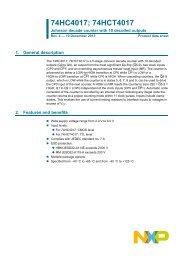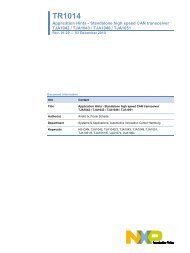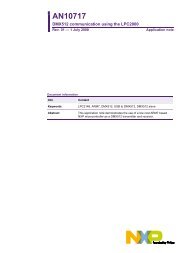AN108711 - NXP Semiconductors
AN108711 - NXP Semiconductors
AN108711 - NXP Semiconductors
Create successful ePaper yourself
Turn your PDF publications into a flip-book with our unique Google optimized e-Paper software.
Philips <strong>Semiconductors</strong><br />
Application Note<br />
Tips and Tricks for PN51x Integration<br />
The Bus Abstraction Layer (BAL) abstracts the physical host controller interface to the<br />
register control layer. This mainly covers the implementation of the interface-specific<br />
details (like I 2 C, RS232...). This component provides two essential commands, which are<br />
named phcsBflBal_Hw1SerWinWriteBus and phcsBflBal_Hw1SerWinReadBus.<br />
These functions hide the type of the interface.<br />
The Register Control (=RegCtl) provides easy access to the registers. This block<br />
consists of commands like phcsBflRegCtl_SerHw1SetReg (Set Register) and<br />
phcsBflRegCtl_SerHw1GetReg (Get Register) and convenience functions like<br />
phcsBflRegCtl_SerHw1ModReg (Modify Register). This is the first interface<br />
independent layer. Time critical issues are done in hardware, hence this block does not<br />
have any timing constraints.<br />
The I/O block provides higher-level commands like phcsBflIo_Hw1Transceive,<br />
phcsBflIo_Hw1Transmit or phcsBflIo_Hw1Receive. Since this block is based on<br />
the RegCtl component, it uses the functions mentioned above to transfer the payload<br />
from / to the PN51x. This component has real time constraints because data has to be<br />
provided in time.<br />
The Operation Control provides the possibility to set certain Operating Modes. This is<br />
done by using the functions like phcsBflOpCtl_Hw1SetAttribute and<br />
phcsBflOpCtl_Hw1GetAttribute. A command could be to set the PN51x in passive<br />
mode. The routines specify static values, hence this component does not have any time<br />
critical operations.<br />
The AUX block contains a single function called phcsBflAux_Hw1Command which<br />
sends and receives a command (seen from the RF side). This function is only used<br />
internally (from I/O). This component has real time constraints because data has to be<br />
provided in time.<br />
The ISO14443-3A block provides commands as specified in the ISO14443-3A standard.<br />
Consequently this interface provides commands like phcsBflI3P3A_Hw1RequestA (for<br />
REQA) or phcsBflI3P3A_Hw1AnticollSelect (for AC and SEL). Time critical issues<br />
are done in hardware, hence this block does not have any timing constraints.<br />
The FeliCa Polling block provides the phcsBflPolAct_Hw1Polling<br />
(POLLING_REQUEST) command in order to check for FeliCa cards. Please note that<br />
other FeliCa commands are not implemented. Time critical issues are done in hardware,<br />
hence this block does not have any timing constraints.<br />
On top of the I/O, higher-level protocols are implemented. This includes the<br />
implementation of Mifare® commands like MIFARE_READ, AUTHENTICATE which are<br />
implemented in the Mifare block. No timing constraints are given.<br />
The NFC block provides the commands, which are specified in the ECMA 340 (ISO/IEC<br />
18092) standard for initiator and target side.<br />
The ID Manager manages the DIDs and CIDs, which are used in the NFCIP-1 protocol<br />
and in the ISO/IEC 14443-4 protocol. The ID Manager does not interact with any PN51x<br />
hardware, hence no timing constraints are relevant.<br />
© Koninklijke Philips Electronics N.V. 2006. All rights reserved.<br />
Application note Rev. 01.10 — 11. May 2006 27 of 37





